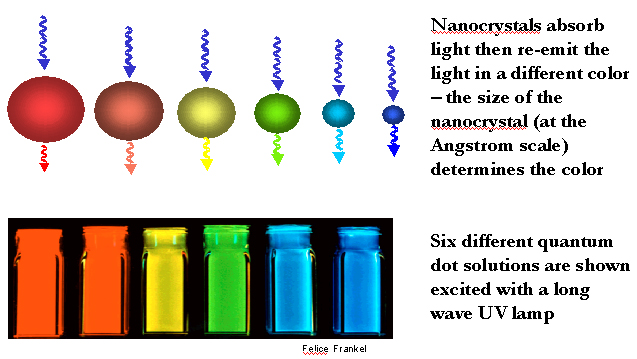
Posted on 05/10/2009 6:36:13 PM PDT by LibWhacker
For more than a decade, scientists have been frustrated in their attempts to create continuously emitting light sources from individual molecules because of an optical quirk called "blinking," but now scientists at the University of Rochester have uncovered the basic physics behind the phenomenon, and along with researchers at the Eastman Kodak Company, created a nanocrystal that constantly emits light.
The findings, detailed online in today's issue of Nature, may open the door to dramatically less expensive and more versatile lasers, brighter LED lighting, and biological markers that track how a drug interact with a cell at a level never before possible.
Many molecules, as well as crystals just a billionth of a meter in size, can absorb or radiate photons. But they also experience random periods when they absorb a photon, but instead of the photon radiating away, its energy is transformed into heat. These "dark" periods alternate with periods when the molecule can radiate normally, leading to the appearance of them turning on and off, or blinking.
"A nanocrystal that has just absorbed the energy from a photon has two choices to rid itself of the excess energy—emission of light or of heat," says Todd Krauss, professor of chemistry at the University of Rochester and lead author on the study. "If the nanocrystal emits that energy as heat, you've essentially lost that energy."
Krauss worked with engineers at Kodak and researchers at the Naval Research Laboratory and Cornell University to discover the new, non-blinking nanocrystals.
Krauss, an expert in nanocrystals, and Keith Kahen, senior principal scientist of Kodak and an expert in optoelectronic materials and devices, were exploring new types of low-cost lighting similar to organic light-emitting diodes, but which might not suffer from the short lifespans and manufacturing challenges inherent in these diodes. Kahen, with help from Megan Hahn, a postdoctoral fellow in Krauss' laboratory, synthesized nanocrystals of various compositions.
Xiaoyong Wang, another postdoctoral fellow in Krauss laboratory, inspected one of these new nanocrystals and saw no evidence of the expected blinking phenomenon. Remarkably, even after four hours of monitoring, the new nanocrystal showed no sign of a single blink—unheard of when blinks usually happen on a scale of miliseconds to minutes.
After a lengthy investigation, Krauss and Alexander Efros from the Naval Research Laboratory concluded that the reason the blinking didn't occur was due to the unusual structure of the nanocrystal. Normally, nanocrystals have a core of one semiconductor material wrapped in a protective shell of another, with a sharp boundary dividing the two. The new nanocrystal, however, has a continuous gradient from a core of cadmium and selenium to a shell of zinc and selenium. That gradient squelches the processes that prevent photons from radiating, and the result is a stream of emitted photons as steady as the stream of absorbed photons.
With blink-free nanocrystals, Krauss believes lasers and lighting could be incredibly cheap and easy to fabricate. Currently, different color laser light is created using different materials and processes, but with the new nanocrystals a single fabrication process can create any color laser. To alter the light color, an engineer needs only to alter the size of the nanocrystal, which Krauss says is a relatively simple task.
The same is true of what could one day be OLED's successor, says Krauss. Essentially, "painting" a grid of differently sized nanocrystals onto a flat surface could create computer displays as thin as paper, or a wall that lights a room in any desired color.
Source: University of Rochester
Oh, lightsaber builders worldwide are going to be SOOO happy!
Reminds me of the first year I bought a house. I changed all the lights in the front of the house to Red party bulbs for Halloween. All the trick or treaters avoided the house like the plague. LOL

Xiaoyong Wang?? Is he a native born AMERICAN who is only loyal to the United States or will China get this technology?
The crystals must have evolved.
My Alma Mater
The crystals must have evolved
May be the crystals came form Mars. Remember Mars needs women?
LOL

· Google ·
Kodak, huh?
Remember Rolf Szabo!
Are you kidding? Ever heard of a few of these traitors: Albert Einstein, Nicolai Tesla, Alexander Graham Bell..
By your reply it is obvious that you also spent 10+ years in college studying the most difficult subjects day and night. In fact I don't doubt that your entire neighborhood is teaming with physicists and chemists who could and should replace Mr Wang tomorrow. If you need a character witness for your interview with Kodak, you can count on me.
I love this team! Ideal Photon Emission
The optical setup will also be used for the optical studies of single carbon nanotubes and the folding, stability and conformational dynamics of proteins.
Pretty cool stuff. If we stay intact then next ten years look to be more advanced than the last twenty.
That’s a big if. ;’) Now that I’m in my fifties, I’ve begun to glimpse what a change my father saw growing up rural from the early 1920s.
Disclaimer: Opinions posted on Free Republic are those of the individual posters and do not necessarily represent the opinion of Free Republic or its management. All materials posted herein are protected by copyright law and the exemption for fair use of copyrighted works.